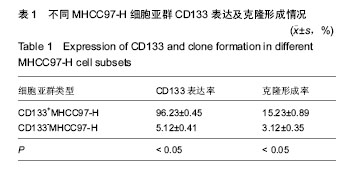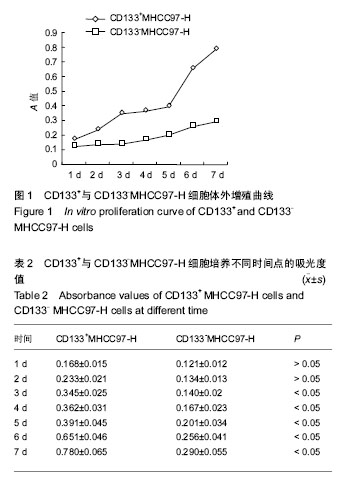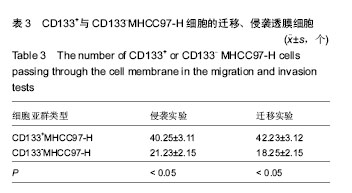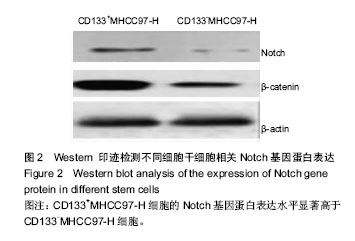| [1] 吴晓慧,王顺祥,崔大鹏,等.CD133和CD90在肝细胞癌中的表达及其意义[J].中华肝脏病杂志,2011,19(5):376-377.[2] 史燕龙,李亚军,康强强,等.131I-CD133mAb诱导CD133+HepG2肝癌干细胞间质-上皮逆转分化[J].第三军医大学学报,2015, 37(11):1086-1090.[3] Lan X,Wu YZ,Wang Y,et al.CD133 silencing inhibits stemness properties and enhances chemoradiosensitivity in CD133-positive liver cancer stem cells.Int J Mol Med.2013; 31(2):315-324.[4] Ma S.Biology and clinical implications of CD133(+) liver cancer stem cells.Exp Cell Res.2013;319(2):126-132.[5] Song YJ,Zhang SS,Guo XL,et al.Autophagy contributes to the survival of CD133+ liver cancer stem cells in the hypoxic and nutrient-deprived tumor microenvironment.Cancer Lett.2013; 339(1):70-81.[6] Huang X,Sheng Y,Guan M,et al.Co-expression of stem cell genes CD133 and CD44 in colorectal cancers with early liver metastasis.Surg Oncol.2012;21(2):103-107.[7] Piao LS,Hur W,Kim TK,et al.CD133 + liver cancer stem cells modulate radioresistance in human hepatocellular carcinoma. Cancer Lett.2012;315(2):129-137.[8] 徐衍,沈永杰,安玉会,等.大豆黄酮对人肝癌SMMC7721细胞己糖激酶活性和癌干细胞CD133蛋白水平的影响[J].河南职工医学院学报,2013,25(3):240-244.[9] 侯妍利,唐敏,陈兴月,等.分离、鉴定CD133+人肝癌干细胞以及131I-CD133mAb对其生物学效应的影响[J].第三军医大学学报, 2014,36(3):222-227.[10] Ma S,Chan KW,Lee TK,et al.Aldehyde dehydrogenase discriminates the CD133 liver cancer stem cell populations. Mol Cancer Res.2008;6(7):1146-1153.[11] Bellizzi A,Sebastian S,Ceglia P,et al.Co-expression of CD133 +/CD44 + in human colon cancer and liver metastasis.J Cell Physiol.2013;228(2):408-415.[12] Ding W,Mouzaki M,You H,et al.CD133+ liver cancer stem cells from methionine adenosyl transferase 1A-deficient mice demonstrate resistance to transforming growth factor(TGF)-beta-induced apoptosis. Hepatology. 2009;49(4): 1277-1286.[13] Zhang J,Luo N,Luo Y,et al.MicroRNA-150 inhibits human CD133-positive liver cancer stem cells through negative regulation of the transcription factor c-Myb.Int J Oncol. 2012; 40(3):747-756.[14] 严威,刘鹏,林芬,等.多药耐药肝癌细胞通过激活Smad3活性富集CD133+亚群细胞[J].中华实验外科杂志,2012,29(3): 548- 549.[15] 侯妍利,陈兴月,段丽群,等.131I标记CD133单链抗体对人肝癌CD133+HepG2干细胞的抑制作用[J].中国肿瘤生物治疗杂志, 2014,21(1):7-13.[16] Rountree CB,Ding W,He L,et al.Expansion of CD133-expressing liver cancer stem cells in liver-specific phosphatase and tensin homolog deleted on chromosome 10-deleted mice.Stem Cells.2009;27(2):290-299.[17] Sakai N,Yoshidome H,Shida T,et al.CXCR4/CXCL12 expression profile is associated with tumor microenvironment and clinical outcome of liver metastases of colorectal cancer.Clin Exp Metastasis.2012;29(2):101-110.[18] 张俊松,汪宏,吴立胜,等.CD105、CD133在人肝癌细胞株HepG-2的表达情况及生物学性状的体外研究[J].肝胆外科杂志, 2013,21(2):133-136.[19] You H,Ding W,Rountree CB,et al.Epigenetic regulation of cancer stem cell marker CD133 by transforming growth factor-beta.Hepatology.2010;51(5):1635-1644.[20] 田静,龚晓萌.CD133和maspin在肝癌中的表达及其临床病理意义[J].中国组织化学与细胞化学杂志,2013,22(6):528-532.[21] Zhang L,Sun H,Zhao F, et al.BMP4 administration induces differentiation of CD133 + hepatic cancer stem cells blocking their contributions to hepatocellular carcinoma.Cancer Res. 2012;72(16):4276-4285.[22] 吴黎明,程彩涛,王江华,等.CD133蛋白在肝癌组织中的表达及其临床意义[J].肿瘤研究与临床,2012,24(10):670-673.[23] Jia Q,Zhang X,Deng T,et al.Positive Correlation of Oct4 and ABCG2 to Chemotherapeutic Resistance in CD90(+)CD133(+) Liver Cancer Stem Cells.Cell Reprogram.2013; 15(2): 143-150.[24] Tang KH,Ma S,Lee TK,et al.CD133 + liver tumor-initiating cells promote tumor angiogenesis,growth,and self-renewal through neurotensin/interleukin-8/CXCL1 signaling. Hepatology. 2012;55(3):807-820.[25] Chen KL,Pan F,Jiang H,et al.Highly enriched CD133(+) CD44(+) stem-like cells with CD133(+)CD44(high) metastatic subset in HCT116 colon cancer cells.Clin Exp Metastasis. 2011;28(8):751-763.[26] Nicolis SK.Cancer stem cells and “stemness” genes in neuro-oncology. Neurobiol Dis.2007;25(2):217-29.[27] 兰曦,王勇,曹姝,等.RNA干扰抑制CD133表达对CD133+肝癌干细胞增殖和化疗敏感性的影响[J].南方医科大学学报,2012, 32(12):1741-1747.[28] Horst D,Scheel SK,Liebmann S,et al.The cancer stem cell marker CD133 has high prognostic impact but unknown functional relevance for the metastasis of human colon cancer. J Pathol.2009;219(4):427-434.[29] 易善永,南克俊,张丽娟,等.肝癌MHCC97 H细胞中CD133+和CD133-亚群分选及其生物学特性[J].中国老年学杂志,2014, 34(15):4267-4269.[30] 兰曦,王勇,曹姝,等.RNA干扰抑制CD133表达对CD133+肝癌干细胞增殖和化疗敏感性的影响[J].南方医科大学学报,2012, 32(12):1741-1747. |
.jpg)




.jpg)